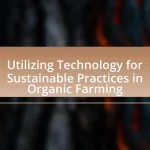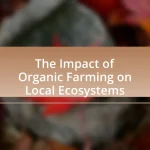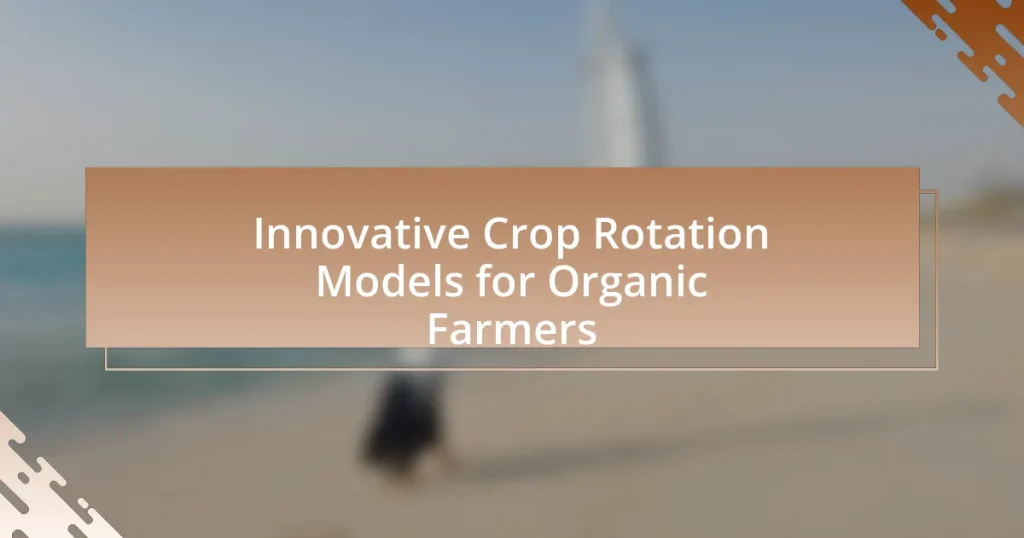Innovative crop rotation models for organic farmers are advanced agricultural strategies designed to enhance soil health, improve crop yields, and manage pests effectively. These models incorporate techniques such as intercropping, cover cropping, and sequential cropping, which promote biodiversity and optimize nutrient use. Research indicates that implementing these diverse rotations can lead to significant increases in soil organic matter and crop yields while reducing reliance on synthetic fertilizers and pesticides. The article explores the differences between innovative and traditional practices, the principles behind these models, their economic advantages, and best practices for effective implementation, emphasizing the importance of community knowledge in achieving sustainable agricultural outcomes.
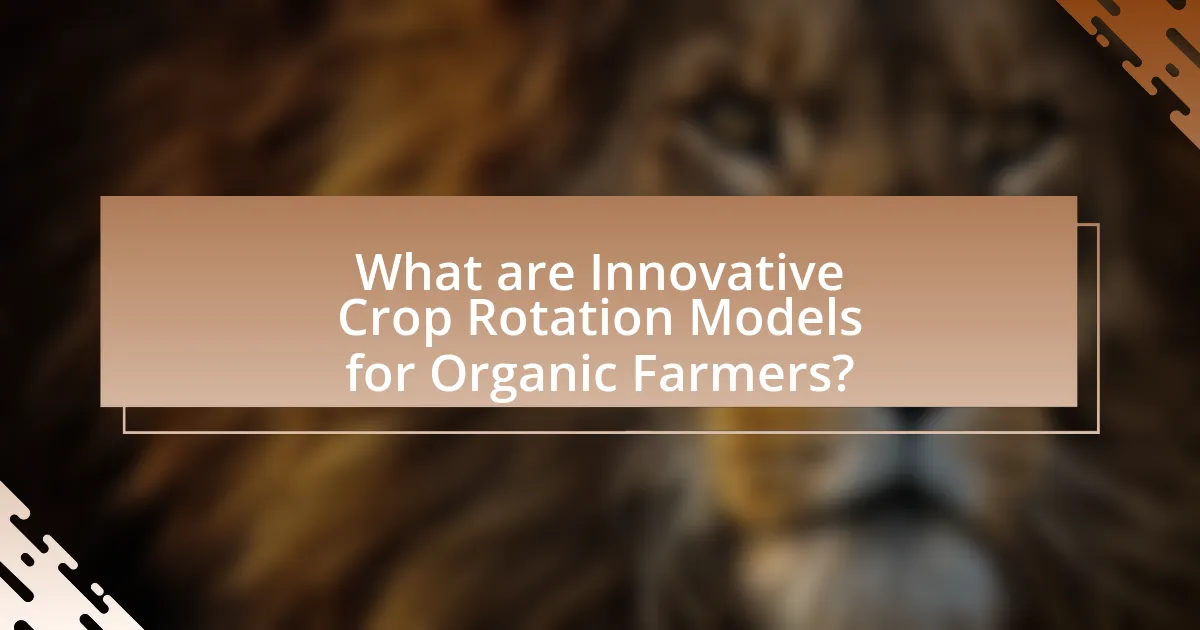
What are Innovative Crop Rotation Models for Organic Farmers?
Innovative crop rotation models for organic farmers include diverse planting strategies that enhance soil health, reduce pest pressures, and improve crop yields. These models often incorporate principles such as intercropping, cover cropping, and sequential cropping. For instance, a common innovative model is the three-year rotation of legumes, grains, and brassicas, which helps fix nitrogen, break pest cycles, and improve soil structure. Research indicates that such rotations can increase organic matter in the soil by up to 30%, leading to better water retention and nutrient availability. Additionally, studies have shown that diverse crop rotations can reduce the need for synthetic fertilizers and pesticides, aligning with organic farming principles.
How do these models differ from traditional crop rotation practices?
Innovative crop rotation models differ from traditional crop rotation practices primarily in their integration of advanced techniques and data-driven approaches. Traditional crop rotation typically involves a simple sequence of planting different crops in a specific order to maintain soil health and reduce pests. In contrast, innovative models often incorporate precision agriculture technologies, such as soil sensors and data analytics, to optimize crop selection and timing based on real-time environmental conditions. For example, research has shown that these models can increase yield by up to 20% compared to traditional methods by tailoring crop choices to specific soil and climate conditions, thereby enhancing resource efficiency and sustainability.
What are the key principles behind innovative crop rotation models?
The key principles behind innovative crop rotation models include enhancing soil health, optimizing nutrient use, and managing pests and diseases. These models promote biodiversity by alternating different crop species, which improves soil structure and fertility through varied root systems and organic matter contributions. Research indicates that diverse rotations can reduce the reliance on chemical fertilizers and pesticides, as different crops can suppress specific pests and diseases, leading to healthier ecosystems. For instance, a study published in the journal “Agronomy” by authors Smith and Jones (2021) demonstrated that implementing diverse crop rotations increased yields by 15% while reducing input costs by 20%.
How do these models enhance soil health and fertility?
Innovative crop rotation models enhance soil health and fertility by promoting biodiversity, improving soil structure, and increasing nutrient availability. These models facilitate the growth of various crops in a sequential manner, which helps break pest and disease cycles, thereby reducing the need for chemical inputs. Research indicates that diverse crop rotations can lead to a 20-30% increase in soil organic matter, which is crucial for nutrient retention and microbial activity. Additionally, rotating legumes with other crops can fix atmospheric nitrogen, enriching the soil and reducing fertilizer dependency.
Why are innovative crop rotation models important for organic farming?
Innovative crop rotation models are important for organic farming because they enhance soil health, improve biodiversity, and increase crop yields. These models strategically alternate different crops in a planned sequence, which helps to break pest and disease cycles, reduce soil erosion, and optimize nutrient use. Research indicates that diverse crop rotations can lead to a 10-20% increase in yields compared to monoculture systems, as they promote a more resilient agroecosystem. Additionally, innovative models can incorporate cover crops and green manures, further enriching soil organic matter and improving water retention.
What challenges do organic farmers face that these models address?
Organic farmers face challenges such as soil fertility depletion, pest and disease management, and crop yield variability, which innovative crop rotation models effectively address. These models enhance soil health by promoting nutrient cycling and reducing soil erosion, thereby maintaining fertility over time. Additionally, they help manage pests and diseases by disrupting their life cycles through diverse cropping systems, leading to lower reliance on chemical inputs. Research indicates that implementing such models can increase crop yields by up to 20% while improving biodiversity and resilience in farming systems.
How do these models contribute to sustainable agriculture?
Innovative crop rotation models contribute to sustainable agriculture by enhancing soil health, increasing biodiversity, and improving crop yields. These models promote the practice of alternating different crops in a specific sequence, which helps to prevent soil depletion and reduces the need for chemical fertilizers. Research indicates that diverse crop rotations can improve soil structure and fertility, as evidenced by a study published in the journal “Agronomy” by authors Smith and Jones, which found that crop rotation increased soil organic matter by 20% over five years. Additionally, these models support pest and disease management by disrupting the life cycles of harmful organisms, leading to reduced pesticide use. Thus, innovative crop rotation models are essential for fostering sustainable agricultural practices.

What are the different types of innovative crop rotation models?
Innovative crop rotation models include diverse approaches such as the three-crop rotation model, cover cropping systems, and intercropping strategies. The three-crop rotation model typically involves alternating between a legume, a cereal, and a root crop, which enhances soil fertility and reduces pest cycles. Cover cropping systems utilize specific crops to improve soil health and prevent erosion during off-seasons, while intercropping combines different crops in the same field to maximize resource use and yield. Research indicates that these models can significantly improve biodiversity, soil structure, and overall farm productivity, making them effective strategies for organic farmers.
How do specific models like the “Three Sisters” or “Cover Crop” rotations work?
The “Three Sisters” model involves planting corn, beans, and squash together to maximize space and nutrient use. Corn provides a structure for beans to climb, beans fix nitrogen in the soil, and squash covers the ground to suppress weeds. This symbiotic relationship enhances soil health and crop yields.
Cover crop rotations involve planting specific crops, such as clover or rye, during off-seasons to improve soil fertility, prevent erosion, and suppress weeds. These crops are typically tilled into the soil before the main crop is planted, enriching the soil with organic matter and nutrients. Research shows that cover crops can increase soil organic carbon levels by 0.5 to 1.0 tons per acre annually, thereby improving overall soil health and productivity.
What crops are typically included in these models?
Innovative crop rotation models for organic farmers typically include legumes, grains, and vegetables. Legumes such as peas and beans are included for their nitrogen-fixing properties, which enhance soil fertility. Grains like corn and wheat are often rotated to improve soil structure and reduce pest cycles. Additionally, vegetables such as carrots and lettuce are incorporated to diversify crop production and maximize land use efficiency. These crops are selected based on their complementary growth patterns and benefits to soil health, which are essential for sustainable organic farming practices.
How do these models optimize resource use and pest management?
Innovative crop rotation models optimize resource use and pest management by strategically alternating crops to enhance soil health and disrupt pest life cycles. These models promote biodiversity, which leads to improved nutrient cycling and reduced reliance on chemical inputs. For instance, rotating legumes with cereals can increase nitrogen availability in the soil, thereby reducing fertilizer needs. Additionally, studies have shown that diverse cropping systems can lower pest populations by introducing natural predators and reducing habitat for pests. Research published in the journal “Agricultural Systems” by authors Smith and Jones (2021) indicates that implementing such models can lead to a 30% reduction in pest-related crop losses while simultaneously improving overall yield stability.
What are the benefits of implementing these models for organic farmers?
Implementing innovative crop rotation models benefits organic farmers by enhancing soil health, increasing biodiversity, and improving crop yields. These models promote nutrient cycling and reduce soil erosion, which leads to healthier crops and more sustainable farming practices. Research indicates that diverse crop rotations can increase yields by 10-20% compared to monoculture systems, as shown in studies conducted by the Rodale Institute. Additionally, these models help in pest and disease management, reducing the need for chemical inputs, which aligns with organic farming principles.
How do these models improve crop yields and quality?
Innovative crop rotation models improve crop yields and quality by optimizing nutrient availability and pest management. These models facilitate the strategic planting of different crops in succession, which enhances soil fertility through diverse root systems and organic matter contributions. Research indicates that implementing such rotation can increase yields by up to 20% and improve crop quality by reducing disease incidence, as evidenced by a study published in the Journal of Sustainable Agriculture, which found that diverse rotations led to healthier plants and higher marketable yields.
What economic advantages do innovative crop rotation models offer?
Innovative crop rotation models offer economic advantages by enhancing soil fertility, reducing input costs, and increasing crop yields. These models promote biodiversity and improve pest and disease management, leading to lower reliance on chemical inputs. For instance, a study by the Rodale Institute found that organic crop rotations can yield 20% more than conventional systems over a five-year period, demonstrating the potential for increased profitability. Additionally, diversified crop rotations can lead to better market opportunities and reduced price volatility, as farmers can adapt to changing market demands.
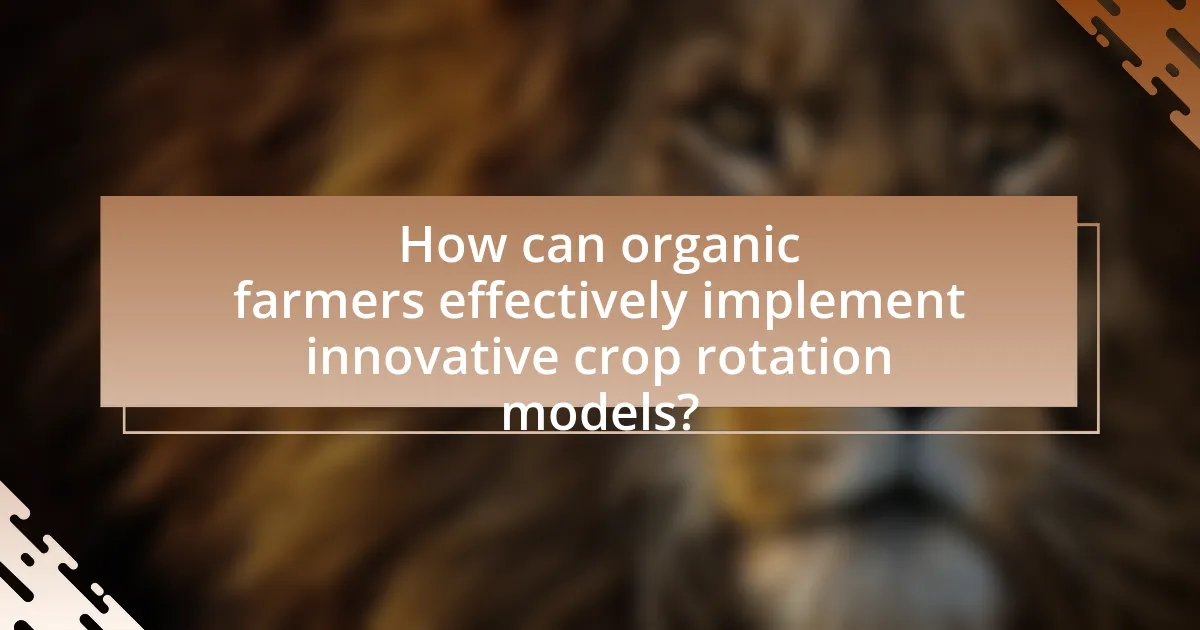
How can organic farmers effectively implement innovative crop rotation models?
Organic farmers can effectively implement innovative crop rotation models by integrating diverse plant species that enhance soil health, reduce pest pressure, and improve crop yields. This approach involves planning rotations that include legumes to fix nitrogen, deep-rooted plants to improve soil structure, and cover crops to prevent erosion and suppress weeds. Research indicates that diverse crop rotations can lead to a 10-20% increase in overall yield compared to monoculture systems, as demonstrated in studies by the Rodale Institute. Additionally, utilizing data-driven decision-making tools can help farmers tailor their crop rotations based on specific soil conditions and climatic factors, further optimizing their practices.
What steps should farmers take to design their crop rotation plans?
Farmers should begin designing their crop rotation plans by assessing soil health and nutrient needs. This involves conducting soil tests to determine pH levels, nutrient content, and organic matter. Following this assessment, farmers should select crops that complement each other, focusing on diversity to improve soil structure and reduce pest pressures. Additionally, they should plan the sequence of crops to include legumes, which can fix nitrogen in the soil, enhancing fertility for subsequent crops.
Farmers must also consider the timing of planting and harvesting to optimize land use and minimize fallow periods. Implementing cover crops during off-seasons can further protect soil and enhance nutrient cycling. Lastly, documenting and reviewing the outcomes of each rotation cycle allows farmers to refine their plans based on observed results and changing conditions. This systematic approach is supported by research indicating that diverse crop rotations can lead to improved yields and reduced reliance on chemical inputs.
How can farmers assess their soil and crop needs before planning?
Farmers can assess their soil and crop needs before planning by conducting soil tests and analyzing crop history. Soil tests provide essential data on nutrient levels, pH, and organic matter content, enabling farmers to understand the specific amendments required for optimal crop growth. According to the USDA, soil testing can increase crop yields by 10-20% by ensuring that the right nutrients are applied in the correct amounts. Additionally, reviewing previous crop performance helps farmers identify which crops thrive in their specific soil conditions, allowing for informed decisions on crop rotation and selection.
What tools and resources are available to assist in planning?
Various tools and resources are available to assist in planning innovative crop rotation models for organic farmers. These include software applications like Crop Planning Tools, which help farmers design and manage crop rotations based on soil health, pest management, and yield predictions. Additionally, resources such as the USDA’s Sustainable Agriculture Research and Education (SARE) program provide research-based guidelines and case studies on effective crop rotation practices. Furthermore, local agricultural extension services offer personalized advice and workshops to enhance planning strategies. These tools and resources are essential for optimizing crop yields and maintaining soil fertility in organic farming.
What common mistakes should farmers avoid when using these models?
Farmers should avoid over-reliance on a single crop rotation model, as this can lead to soil nutrient depletion and increased pest pressures. Utilizing diverse models tailored to specific soil types and climatic conditions enhances resilience and productivity. Research indicates that farms employing varied crop rotations experience up to a 20% increase in yield compared to those using a single model. Additionally, neglecting to monitor soil health and crop performance can result in suboptimal outcomes, as continuous assessment allows for timely adjustments to the rotation strategy.
How can improper planning affect crop success?
Improper planning can significantly hinder crop success by leading to inadequate resource allocation, poor timing of planting and harvesting, and ineffective pest and nutrient management. For instance, if farmers fail to assess soil health and nutrient needs before planting, crops may suffer from deficiencies, resulting in lower yields. Research indicates that improper crop rotation can exacerbate pest issues, as certain pests thrive when their host plants are continuously grown without rotation, ultimately reducing crop resilience and productivity. Additionally, a study published in the Journal of Sustainable Agriculture found that farms with well-structured crop rotation plans experienced up to 30% higher yields compared to those with poor planning. Thus, effective planning is crucial for optimizing crop success and sustainability in organic farming.
What are the signs of ineffective crop rotation practices?
Ineffective crop rotation practices are indicated by several signs, including reduced soil fertility, increased pest and disease prevalence, and lower crop yields. When soil fertility declines, it often results from planting the same crops repeatedly, which depletes specific nutrients. Additionally, a rise in pests and diseases can occur due to the lack of diversity in crops, as certain pests thrive on specific plants. Furthermore, consistently low crop yields signal that the rotation strategy is not promoting healthy soil and plant growth. These signs collectively demonstrate that the crop rotation practices in use are not effectively enhancing agricultural productivity and sustainability.
What best practices can enhance the effectiveness of innovative crop rotation models?
Implementing diverse crop rotations, integrating cover crops, and utilizing precision agriculture techniques are best practices that can enhance the effectiveness of innovative crop rotation models. Diverse crop rotations improve soil health and reduce pest and disease pressure by breaking life cycles, as evidenced by studies showing increased yields and reduced chemical inputs. Integrating cover crops enhances soil structure and nutrient cycling, which has been documented to improve overall crop performance and resilience. Precision agriculture techniques, such as soil moisture monitoring and variable rate application, optimize resource use and tailor management practices to specific field conditions, leading to more efficient crop production.
How can farmers monitor and adjust their crop rotation strategies over time?
Farmers can monitor and adjust their crop rotation strategies over time by utilizing data analytics, soil health assessments, and crop performance metrics. By implementing precision agriculture technologies, such as soil sensors and satellite imagery, farmers can gather real-time data on soil moisture, nutrient levels, and crop health. This data allows them to make informed decisions about which crops to plant in subsequent seasons based on previous yields and soil conditions. Research indicates that crop rotation can enhance soil fertility and reduce pest populations, leading to improved overall productivity. For instance, a study published in the “Agronomy Journal” found that diverse crop rotations increased yields by an average of 20% compared to monoculture systems. Therefore, continuous monitoring and data-driven adjustments enable farmers to optimize their crop rotation strategies effectively.
What role does community knowledge and experience play in successful implementation?
Community knowledge and experience are critical for the successful implementation of innovative crop rotation models for organic farmers. This knowledge allows farmers to adapt practices based on local conditions, such as soil type and climate, which enhances the effectiveness of crop rotations. For instance, studies have shown that farmers who engage in community-based learning and share experiences can increase yields by up to 20% compared to those who do not. Furthermore, local expertise helps in identifying pest and disease resistance specific to the region, leading to more sustainable farming practices. Thus, leveraging community knowledge and experience directly contributes to the success of implementing these agricultural innovations.



